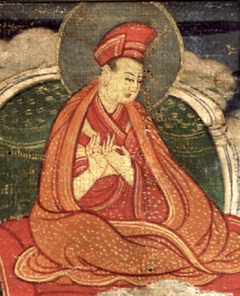Brief Commentary on Twelve Stanzas
A Brief Commentary on the Twelve Stanzas (Including the Divisions of the Stages of the Path for Individuals of the Three Capacities)
by Gompa Tsultrim Nyingpo
Homage to the noble gurus!
Generally, at the beginning when setting out on the path, as in all cases, both teacher and student must possess certain characteristics. What is required of the guru? This is addressed in the line beginning, "You never allow vows... etc." That is to say, whichever vows the guru has taken must not have deteriorated. "Commitment" here does not refer to mantra commitments (i.e., samaya). One's guru, who is sincere in his or her commitments, must have respect for all gurus that does not wane.
In addition, he or she must hold a lineage that has the three aspects of scriptural transmission, realization and blessings. The oral lineage of Jowo Atiśa is said to possess these three.
The way to follow a guru who originates from such a background is not to be casual or lacking in respect, but just as indicated in the line that begins, "I offer obeisance from my bones..."
The lines about vehicles here, briefly stated, do not concern what is called "the secret pathway of Vajrasattva". Rather, they concern the great 'main route' taken by all the buddhas and bodhisattvas of the three times.
There follows a division into four:
1) turning the mind to the Dharma,
2) Dharma progressing along the path,
3) the path clarifying confusion, and
4) confusion dawning as wisdom.
For each of these, there are also the three aspects of view, meditation and conduct by means of which they are practised.
For the first, there is the correct mundane view of having confidence in the effects of actions, meditation on karmic cause and effect, the [conduct of] refraining from harmful actions and engaging in virtue, and the result, which is [rebirth among] devas and human beings.
Then, there is the view of the absence of personal identity and perceived object, meditation on the faults of saṃsāra, the conduct on the śīla (i.e., ethical discipline) of renunciation and so on, and the result of becoming a śrāvaka and pratyekabuddha.
Then, there is the view of the two truths of noble beings, of which the relative is the means and the ultimate is wisdom. Meditation is on the unity of these two. Conduct is to generate a mind that is set upon supreme awakening and then to train in the six transcendent perfections. And the result of these is to attain omniscient buddhahood.
To explain this a little, in reference to the ground, if you hold up something like an iron[1] in the naturally clear sky, you might wonder where the space that it occupies has now gone, but it has not gone anywhere. Then, when that thing is no longer there, you might wonder where the space came from in its wake, but it did not come from anywhere. If you were then to use the sharp weapon of intelligence to cut and break apart this iron you would find that nothing, not even the subtlemost particle, remains. This is the meaning of 'form is emptiness.' The fact that it still appears as the mere illusory relative is what is meant by 'emptiness is form.' Thus, it is said that there is emptiness none other than form and form is none other than emptiness, and this is the instruction for establishing form as empty.
While the ultimate is like this, not allowing anything that appears on the relative level to become an object of attachment or aversion creates the favourable conditions for training in bodhicitta as the method.
In this way, the two truths serve as method and wisdom. And meditating on these two brings about the fruition of the two kāyas.
Here, verbal indications are not enough, there must be signs of progress: giving your own happiness to others and taking others' suffering upon yourself.
When you are harmed, by understanding this to be in the nature of beings you will remain unperturbed and not retaliate. Empty words with no basis in reality will not help.
Not seeking to gain [pleasure] and avoid [pain] because neither is genuinely real, you will feel equanimity towards the eight worldly concerns.
Clinging to self and other when they are no different in their nature and feeling attachment and aversion is unreasonable. Thus, you will let go of the wish to abandon an evil saṃsāra and attain a positive nirvāṇa.
Interdependence and emptiness are synonyms. Therefore, since all apparent things are interdependent, there is no need to look for a separate teacher of emptiness.
All states such as physical illness,[2] happiness, unhappiness and so on are not genuinely real. And if you understand the fabrications of your own mind, everything that appears becomes a support for mind training. When this happens, what need is there for a separate means of eliminating hindrances? There is none.
This was copied from the personal text of Ācārya Gompa. It was extracted from the collected writings of Drukpa Pema Karpo.
| Translated by Adam Pearcey, 2018. With the kind assistance of Alak Zenkar Rinpoche.
Bibliography
Tibetan Edition
"skyes bu gsum gyi lam rim phyed bcas sho lo ka bcu gnyis pa'i 'grel pa mdor bsdus" In bka' brgyud pa'i zhal 'don phyogs bsgrigs. Bod ljongs mi dmangs dpe skrun khang, 1997, pp. 190–192
Version: 1.3-20250219
